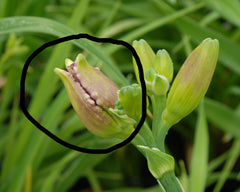Don't you just hate these unnamables!?
OK..........I just don't want to acknowledge these little........well, let's just say the unnamables as we hate to say the word around here.
GALL MIDGE
Ok I said it; hopefully I won't be cursed now. But what are they, how do you identify them and how do you get rid of them.

The above picture shows the basic form of a galled bud in a normal round formed daylily on the left. The bud on the right is normal.

This picture shows a long slender bud of a spider form daylily. The galled bud is on the right and the normal bud on the left.
According to the American Hemerocallis Society:
Contarinia quinquenotata is a small fly which has is a pest of daylilies in Europe and Canada. Maggots develop inside daylily flower buds causing them to become inflated, distorted and unable to open properly. Some buds may dry up. Reports indicate that in some cases clumps may be so badly affected that few buds open normally. Early flowering daylilies are typically the most heavily infested and egg-laying may have ceased by the time later flowering daylilies are forming buds, allowing them to escape much of the damage. Infested buds may contain from one or two up to a hundred or more small white legless larvae up to around 0.12" in length which, when sufficiently mature, fall to the ground where they overwinter. Thus far it appears this insect only has one generation each year. In spring they emerge as adults and fly to daylily buds to lay their eggs. Because they are inside the galled buds, larvae are protected from contact insecticides. Also, since the adults are flying for several weeks each season, it will be difficult to provide sufficiently continuous contact insecticide coverage to prevent egg-laying. Treatment involves removing affected buds as soon as it is obvious that they have been attacked. These buds must then be destroyed so that the maggots within them cannot continue their life cycle. Some gardeners destroy the maggots by burning the infested buds, but other alternatives need to be determined where burning is not possible. Do not compost infested buds unless the larvae have already been killed by some means. Some gardeners use early flowering daylily cultivars particularly favored by the midges as "trap plants" to assist in collection of infested buds. Daylilies purchased in pots or with intact budded scapes are more likely to introduce the pest to a new area than daylilies acquired bare-root and without scapes. Some gardeners destroy the maggots by burning the infested buds, but other alternatives need to be determined where burning is not possible. Do not compost infested buds unless the larvae have already been killed by some means. Daylilies purchased in pots or with intact budded scapes are more likely to introduce the pest to a new area than daylilies acquired bare-root and without scapes.
So what can you really do? The most effective (but still short of 100%) is to hand pick the galled buds. If you have only a few daylilies it is quite an easy task. I place them in a bag and freeze them prior to discarding. Other people seal the bag and place in the sun to heat them and I have also heard of microwaving them (and you thought the freezer was bad!). Most importantly DO NOT PUT THEM LIVE ON ANY COMPOST PILE and DO NOT LEAVE THEM ON THE SCAPE! You can also opt to only have mid season or later hemerocallis thereby eliminating the time window when the midges are laying eggs.









